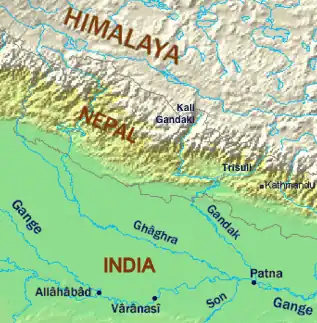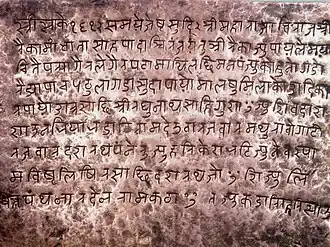Baise Rajya


The Baise Rajya (Nepali: बाइसे राज्यहरू, lit. ‘22 kingdoms’) were sovereign and intermittently allied petty kingdoms in the western hills of what is now Nepal, located around the Karnali–Bheri river basin. These kingdoms were ruled by local dynasties, including both Magar and Khas chieftains, depending on the region. Several of these kingdoms, particularly in areas like Rukum, Rolpa, and Pyuthan, had strong Magar leadership and populations. The Baise states maintained varying degrees of independence until they were gradually annexed during the unification of Nepal from 1744 to 1810. Although Prithvi Narayan Shah (r. 1743–1775), the founder of the Gorkha kingdom, initiated the unification, it was completed under his successors by the end of the 18th century.
The 22 principalities were Jumla, Doti, Jajarkot, Bajura, Gajur, Malneta, Thalahara, Dailekh District, Dullu, Duryal, Dang, Sallyana, Chilli, Tulsipur State, Darnar, [1] Atbis Gotam, Majal, Gurnakot, and Rukum.[a] These Baise states were ruled by Khasas and several decentralized tribal polities.[3]
List of Rajyas (22 states)
| Rajya | Annexation to Nepal | Notes |
|---|---|---|
| Atbis Gotam[4] | 1786 | Also known as Gutam. |
| Bajura | August 1791 | Became a vassal state of the Kingdom of Nepal. |
| Biskot | 1782 | Also possibly known as Bosakot. |
| Chilli | . | Descended from Raja Malaibam, Raja of Bajhang in the 14th century. |
| Dailekh | . | . |
| Dang Tulsipur | 1786 | Founded around 1350, by a scion of the predecessor Kingdom of Sarasvati House of Tulsipur |
| Darnar | . | Also spelled Darna, it became a vassal state of the Kingdom of Nepal. |
| Doti[5] | 1786 | . |
| Dullu | 1790 | Also known as Raskot, it was founded by a division of the Kingdom of Mailbham around 1378. |
| Duryal | . | . |
| Gajur | . | . |
| Gurnakot | . | Possibly the same as Garhunkot, it became a vassal state of the Kingdom of Nepal. |
| Jajarkot | . | Became a vassal state of the Kingdom of Nepal, also known originally as Jagatipur.[6] |
| Jehari | . | Descended from Raja Malaibam, Raja of Bajhang in the 14th century. |
| Jumla | October 1788 | Annexation date also given as September 1789. |
| Majal | . | . |
| Malneta | . | Became a vassal state of the Kingdom of Nepal. |
| Musikot | 1786 | Descended from Raja Malaibam, Raja of Bajhang in the 14th century. |
| Phalawagh | . | Possibly the same as Salyana. |
| Rukum | . | Descended from Raja Malaibam, Raja of Bajhang in the 14th century. |
| Salyana | 25 September 1786 | It was made a vassal state after annexation and was ultimately abolished in 1961,[7] with the Raja still receiving a Privy Purse until the abolishment of the Nepali monarchy. |
| Thalahara | . | Became a vassal state of the Kingdom of Nepal. |
A parallel confederation of 24 principalities Chaubisi rajya (Nepali: चौबिसी राज्य) occupied most of the Gandaki basin east of the Baisi.
See also
Notes
Citations
- ^ Account of the Kingdom of Nepal, and of the Territories annexed to this Dominion by the House of Gorkha by Francis Hamilton (formerly Buchanan) M.D., 1819
- ^ Pradhan 2012, p. 4.
- ^ Pradhan 2012, p. 3.
- ^ Extract from 'The Gurkhas' of Eden Vansittart (based upon the 'Notes on Nepal', 1895 AD and 'Notes on Gurkhas' 1890 AD), Anmol Publications, New Delhi, Re-print 1993
- ^ "Sketches from Nipal, Historical and Descriptive with Anecdotes from......" by Henry Ambrose Oldfield, M.D.; W.H.Allen & Co., London, 1880. Vol.I, P.23
- ^ Baise Chaubise Parichaya (An introduction to the Baise and Chaubise principalities). Nepali, quarterly. Published by the Madan Puraskar Guthi, Sridarbartol, Lalitpur, Magh-Chaitra, 2032 (January–March 1976), pp. 3-38. [Mahan Bahadur Malla]
- ^ "The Rajya Rajauta Ain" (Rajya System Abolition Act) of 2019 V.S. (1961)
Sources
- Pradhan, Kumar L. (2012), Thapa Politics in Nepal: With Special Reference to Bhim Sen Thapa, 1806–1839, New Delhi: Concept Publishing Company, ISBN 9788180698132